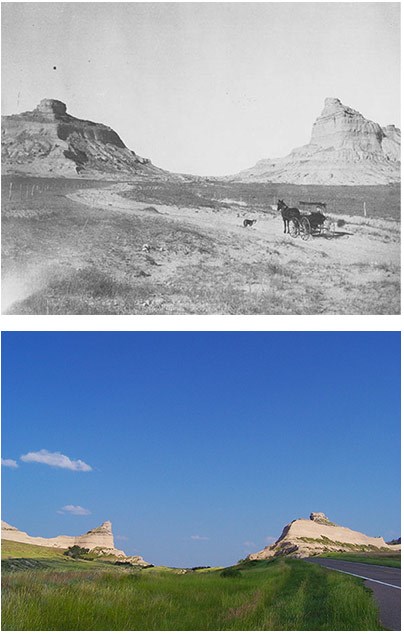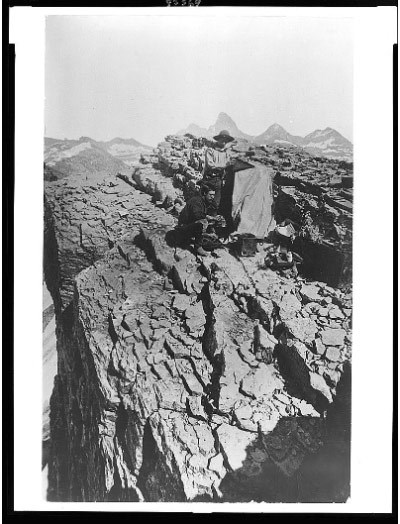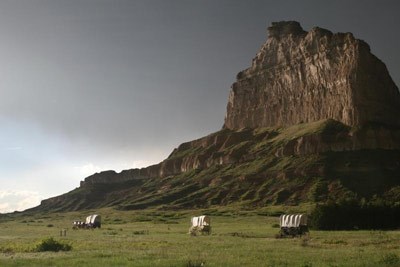Quick Facts
- Cultural Landscape: Scotts Bluff National Monument
- Park: Scotts Bluff National Monument
- Periods of Significance:
1841-1869 Westward Expansion Movement
1927-1948 Development as National Monument/Federal Work Programs
- Featured Artwork: Wagon Train, William Henry Jackson
- Midwestern Region Poster (Download PDF)
In the mid-1800s, great numbers of emigrants began making the 2,000 mile journey over the Oregon Trail, following routes first established by Native Americans and fur traders to travel from Missouri to the distant Oregon Territory.

Above: Image courtesy of North Platte Valley Museum, from Cultural Landscape Inventory report. Below: NPS Photo/R. Reed, 2014
Oregon and California Trails followed the same route until the trail split in two in Idaho, with one heading toward Oregon and the other heading to California. Chimney Rock is the most frequently mentioned landmark in diaries and journals of the emigrants. The area between Scotts Bluff and South Bluff was also known as Mitchell Pass, or "The Gap."
The early trail route followed the south side of the North Platte River until it approached the badlands area of New Scotts Bluff. At that point, travelers had to make a wide swing through Robidoux Pass, because the terrain through Mitchell Pass would not accommodate wagons. Then, beginning in 1850, pioneers excavated the most treacherous segments through the Pass which significantly shortened the travel distance by about eight miles. While that may not seem like a large amount for such a long voyage, it eliminated a full day's travel for wagons on the trail. Emigrants reaching these landmarks and successfully navigating the Pass would have completed one-third of the journey to Oregon.
William Henry Jackson
William Henry Jackson (1843-1942) was an American painter, Civil War veteran, businessman, geological survey photographer, and an explorer. According to some who knew him, the legend of the man is as vast and vibrant as the Western landscapes he painted.

Library of Congress Prints and Photographs Division, Catalog Number 93510825
"Anyone meeting him was instantly riveted by his brilliant, sparkling eyes peering out over his spectacles, which were always halfway down his nose. Then the attention would focus on his personality and stream of memories. ...
"He was such as electric personality and presence that only those privileged to experience him in person can even begin to describe him and appreciate him. They can only remember him and miss him, smile quietly and be grateful that this man touched their lives. Never would I, or anyone else that knew him, forget his rapid, high pitched voice telling an exciting story, his grabbing a pencil and paper to illustrate part of an adventure seventy years before, his burst of laughter recalling an episode from the past, his appreciation of people and his inability to condemn or criticize anyone, and above all his love for his country and its history."
Marian Albright Schenck (daughter of NPS Director Horace Albright), November 6, 1997, from Introduction to An Eye for History: The Paintings of William Henry Jackson
The relatively slow pace of wagon trains crossing the overland trails makes the voyage appear deceptively peaceful. River crossings, unpredictable weather, illness, and shortage of supplies made life on the trail an endurance test with both physical and psychological challenges.

William Henry Jackson. Held by and displayed with permission of NPS/Scotts Bluff National Monument (SCBL_143a).

NPS/Scotts Bluff National Monument

NPS, SCBL Archives
Last updated: June 28, 2018

